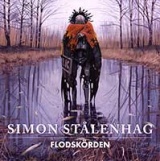The best way to describe Simon Stålenhag's[a] work is uncanny. With his meticulous attention to detail and almost-believable futuristic constructs, looking at his paintings of an alternate-reality 90's Sweden is like looking at an old family photo and realizing that there's someone in the photo that you've never seen before and can't remember even though you somehow think you should.

ISBN: 9789187222283
Fria Ligan, 2016
Swedish and English
- Editions
- Things From the Flood
English edition from Design Studio Press
ISBN: 9781624650468
- Things From the Flood
An amazing and uncanny alternate-history of Sweden in the 90's, that mixes scenes of everyday life with futuristic megastructures in a wonderful, smooth fusion of both. (5/5)
I had seen Simon's paintings just as he started making waves on the Internet back in 2013 with his mirror-universe Sweden full of boxy Volvos and futuristic megastructures that the people in the paintings seemingly treated as part of their everyday life. But it wasn't until I saw an ad for his latest book, Passagen (The Electric State)[b], clicked through to his Facebook fanpage[c] and saw Den ryska nallen (The Russian Teddy Bear)[d]. I instantly recognized the location - after all, I grew up about a hundred meters from there: Lofotengatan 43[e]. The gigantic tower, or "Vertical City"[f] as it is called in this alternate universe, had obviously taken its inspiration from the facades in Akalla, specifically the houses along Sibeliusgången[g].
That was it. I was hooked.
The book itself is built around a universe in which the Swedish government built a gigantic particle accelerator and / or power station under Lake Mälaren in the 1950's, colloquially called "The Loop". Since the Loop isn't really understood even by its builders, it has a propensity to play havoc with the local space-time of the suburban inhabitants of the islands in the lake. When Things From the Flood starts, people have grown weary of having the fabric of their reality get yanked around and the Loop has shut down. But even though people are done with the Loop, the Loop isn't done with them, and dark water comes flooding out of the abandoned tunnels below the idyllic countryside.
Simon Stålenhag, who narrates the story, is a teenager growing up and observing the events from a distance, having been evacuated along with the other inhabitants of the area. The story is told in short paragraphs that briefly and factually explain what he saw and experienced. He tries to make sense of events, but like most teenagers, his main concern is doing teenage stuff - play Doom, make friends, play dangerous games with the semi-intelligent robots that the government keeps.
The end result is a smooth fusion of everyday life with fantastic futurism. A world which is very recognizable, yet a bit off. It's not real, yet could well be.
Links
http://www.simonstalenhag.se/ | |
http://frialigan.se/sv/butik/?product_id=73967304709 | |
https://www.facebook.com/simonstalenhagofficial/ | |
https://www.redbubble.com/people/simonstalenhag/works/21525397-den-ryska-nallen?c=515445-vertikalst-der | |
https://www.google.se/maps/@59.4121888,17.9267635,3a,75y,216.12h,87.94t/data=!3m6!1e1!3m4!1sg1nWE-M7--px2VZr-utrZw!2e0!7i13312!8i6656?hl=en | |
https://www.redbubble.com/people/simonstalenhag/collections/515445-vertikalst-der | |
https://www.google.se/maps/@59.415809,17.9133957,3a,90y,205.2h,115.54t/data=!3m7!1e1!3m5!1s_DJs6kMadkTGxuuSyJUAhg!2e0!6s%2F%2Fgeo1.ggpht.com%2Fcbk%3Fpanoid%3D_DJs6kMadkTGxuuSyJUAhg%26output%3Dthumbnail%26cb_client%3Dmaps_sv.tactile.gps%26thumb%3D2%26w%3D203%26h%3D100%26yaw%3D335.57913%26pitch%3D0%26thumbfov%3D100!7i13312!8i6656 |